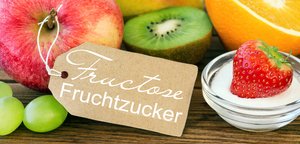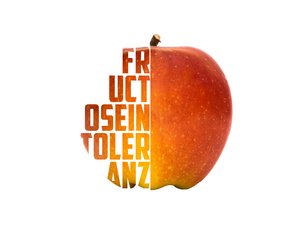Free from fructose
Fructose intolerance - symptoms
Mostly, the consumption of fructose triggers flatulence and diarrhea. These symptoms are harmless in themselves, but very unpleasant and stressful for those affected. So-called hereditary fructose intolerance, however, has more severe consequences: In addition to nausea and vomiting, confusion, dizziness, sweating and even seizures occur.
People with this intolerance can usually tolerate a certain amount of fructose. When the natural absorption capacity for fructose is exceeded, the excess fructose enters the large intestine, where it causes the undesirable symptoms. The breakdown of fructose produces gases (including hydrogen, carbon dioxide and methane) and short-chain fatty acids.
People with hereditary (congenital) fructose intolerance have to avoid fructose altogether. Even small amounts of fructose can cause serious problems such as liver and kidney damage.
The situation is different with the more common acquired fructose intolerance (fructose malabsorption). In this case, a complete renunciation of fructose is neither necessary nor sensible. Those affected can usually tolerate small amounts of fructose of less than 25 grams. If you still strictly avoid fructose, you may become even more sensitive in the long run and tolerate less and less of it.
Instead, a special dietary therapy consisting of three phases is recommended for acquired fructose intolerance: Abstinence phase, test phase and permanent nutrition. In the course of this nutritional therapy, the fructose content of the food as well as the composition of fats and proteins are changed - best with the help of a nutrition advisor, for example, to avoid nutritional deficiencies. A fructose intolerance table is also a valuable companion for those affected. It indicates the fructose content in certain foods.

What is fructose?
Fructose (from Latin fructus "fruit", outdated levulose, colloquially fruit sugar) is a naturally occurring chemical compound. As a monosaccharide (simple sugar), fructose belongs to the carbohydrates. It occurs in several isomeric (anomeric) forms. In this article, the information on physiology concerns only D-fructose. L-fructose is practically meaningless.
Occurrence
Fructose as a simple sugar occurs naturally mainly in pome fruits (in apples and pears at about 6 g/100 g each)[2], berries (for example, grapes at 7.5 g/100 g)[11] as well as in exotic fruits (pomegranate and persimmon), honey (35.9-42.1 g/100 g)[21] and in artificial honey. Household sugar (sucrose, also cane sugar if made from sugar cane, or beet sugar if made from sugar beet) is a twofold sugar composed of one molecule of glucose (grape sugar) and fructose respectively. A significant proportion of sugar intake comes from industrially produced foods that contain high-fructose corn syrup (HFCS)

Industrial production
Fructose is industrially obtained from vegetable starches such as corn starch. By adding the enzyme amylase, corn syrup is first produced from dissolved corn starch and, in a further reaction, high-fructose corn syrup (HFCS) is produced by adding glucose isomerase, e.g. HFCS-42 (with 42% fructose and 53% glucose in dry matter) and HFCS-55 (with 55% fructose and 41% glucose in dry matter, second generation HFCS from 1976 onwards).[14][15] Since about 1972, the enzymes have been immobilised, which brought the production costs of HFCS in the USA below the import costs of sucrose. [14] At the same time, this was also the first large-scale application of enzyme immobilisation[14] and it represents the largest technical use of immobilised enzymes in the world in terms of volume.[15] In addition, HFCS-90 with 90% fructose content is still produced by chromatography, which is used to produce HFCS-55 by dilution with HFCS-42.[14] Most soft drinks in the USA use HFCS-55, while most other HFCS-sweetened foods use HFCS-42.[16]
In the USA, corn (more precisely: corn syrup) is almost exclusively used as a glucose source for the production of isoglucose, which is a mixture of glucose and fructose, as fructose has a higher sweetening power with the same physiological calorific value of 374 kilocalories per 100 g. The annual global production volume of isoglucose is eight million tonnes (as of 2011).[17] Glucose syrup is used to produce HFCS with the help of immobilised glucose isomerase. [18] The glucose isomerase (more precisely xylose isomerase) used in this process is derived from Bacillus coagulans,[15] Streptomyces rubiginosus[15] or Streptomyces phaeochromogenes.[15] The reaction is carried out at a pH of 7.5-8.2 and a temperature of 55-60°C. [19] The glucose syrup produced from starch is used to produce fructose after removal of calcium ions, since calcium ions are cofactors of amylase in the enzymatic production of glucose syrup, but inhibitors of xylose isomerase in the subsequent conversion to fructose - in which magnesium ions are the cofactors.[20] To a lesser extent, invert sugar is produced, as a mixture of glucose and fructose by hydrolysis of sucrose.
Further information: Wikipedia "Fructose"
References
[2] Entry on D-Fructose. In: Römpp Online. Georg Thieme Verlag, retrieved 18 March 2018.
[11] Entry on Weintraube. In: Römpp Online. Georg Thieme Verlag, retrieved 3 May 2012.
[12] Entry on Honig. In: Römpp Online. Georg Thieme Verlag, retrieved 3 May 2012.
[13] Search the USDA National Nutrient Database for Standard Reference. Nal,usda,gov, archived from the original on 3 March 2015; retrieved 10 December 2014.
[14] Byong H. Lee: Fundamentals of Food Biotechnology. John Wiley & Sons, 2014, ISBN 978-1-118-38491-6, p. 332.
[15] Andreas Liese: Industrial Biotransformations. John Wiley & Sons, 2008, ISBN 978-3-527-61417-2, p. 388.
[16] High Fructose Corn Syrup: Questions and Answers. US Food and Drug Administration, 5 November 2014, archived from the original on 25 January 2018; retrieved 18 December 2017.
[17] Thomas Becker, Dietmar Breithaupt, Horst Werner Doelle, Armin Fiechter, Günther Schlegel, Sakayu Shimizu, Hideaki Yamada: Biotechnology, in: Ullmann's Encyclopedia of Industrial Chemistry, 7th edition, Wiley-VCH, 2011. ISBN 978-3-527-32943-4. Volume 6, p. 48.
[18] Atsuo Tanaka: Industrial Application of Immobilized Biocatalysts. CRC Press, 1992, ISBN 978-0-8247-8744-8, p. 185.
[19] Benjamin Caballero, Paul Finglas, Fidel Toldrá: Encyclopedia of Food and Health. Academic Press (2016). ISBN 978-0-12-384953-3, Volume 3, p. 608.
[20] Ashok Pandey: Industrial Biorefineries and White Biotechnology. Elsevier, 2015, ISBN 978-0-444-63464-1, p. 488.
